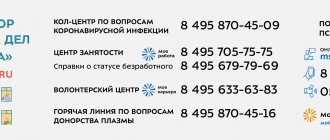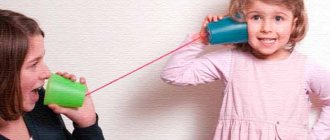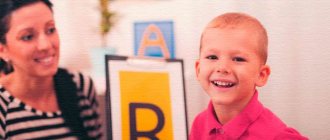Speech development of children 5-6 years old: norms and deviations
Most parents realize that their child needs consultation with a speech therapist when preparing for school. At this age, children begin to be prepared to master reading and writing skills. For this you need a base - competent speech. The classes become more complicated, and some children have difficulties at this stage.
Developmental activity
Norms for the development of children's speech at the age of 5 to 6 years
To determine whether a preschooler has a delay in speech development, you need to know what is the norm by the age of five or six:
- the child communicates through detailed sentences using facial expressions and gestures;
- uses generalizing words in speech;
- correctly uses numerals, adverbs, pronouns, conjunctions, particles;
- a preschooler learns to use participial and participial phrases;
- there is an extensive vocabulary;
- masters word formation skills (for example, diminutive forms of words);
- sound pronunciation is almost formed;
- the syllable structure is fully formed;
- A preschooler can make up a short descriptive story based on a picture.
Note! During this age period, children's speech is already as close as possible to that of an adult.
Errors occur if the child talks about a phenomenon unfamiliar to him or uses a new word. The sound pronunciation side is almost completely formed: in the fifth year there may be disturbances in the pronunciation of sonorant sounds - R and L.
At this age, a preschooler knows how to use intonation, so theatrical performances are staged with children. At the age of six, he already remembers poems well and can retell short stories. The level of development of children's speech depends on the efforts that adults make to raise the child.
Reading
Symptoms of delayed speech development at 5-6 years old
If in the sixth year a preschooler communicates with simple, uncommon sentences or phrases, and the pronunciation of most sounds is impaired, then parents should contact a speech therapist. Adults have difficulty understanding children's speech; it is inexpressive; the child has difficulty memorizing poems and retelling short texts.
Note! In children with speech disorders, the passive vocabulary significantly exceeds the active one. However, he may use some words inaccurately.
The vocabulary mainly consists of nouns, with a smaller number of adjectives and verbs. Phrases and sentences are ungrammatical: agreement norms are violated, prepositions and conjunctions are omitted. If adults notice the above signs, then it is necessary to make an appointment for speech therapy.
Defectological assistance in educational institutions for preschool children
Self-diagnosis of speech delay
Parents can independently determine whether everything is okay with their children’s speech at 5 years old. To test your vocabulary, you can offer the following activities:
- ask what a particular person does, how an object acts. For example, “What does a ship do?” (floats). “What is grandpa doing?” (digs a bed);
- are asked to name opposite actions, for example, “sitting - raised, open - closed” or opposite signs, for example, “light - heavy, soft - hard”;
- offer to name the baby animals, for example: “Who has a baby goat? Boy. Who has a bear? Teddy bear. Who has a cow? Calf. Who has a horse? Foal" and so on;
- check if he knows the basic colors and shades, shapes of objects (triangular, round, square, oval, rectangular, polygonal);
- see if he can describe the object, for example, “Which chair? Soft, made of wood, brown, on metal legs”;
- suggest getting an object that is under the box, on the box, above the box, under the box, in front of the box, behind the box, in the box, between the boxes to determine the correct use of prepositions.
- forms the plural of a word, as in “This is a leg, and these are... legs. This is a window, and these are...windows. This is a sparrow, and this is. sparrow";
- drop the noun: “What is this? No book what? Books. What was deleted? Book. Why install a laptop? To the book. How did I close the notepad? Book. What are we talking about? About the book";
- he changes the word to use it differently: “The son came to the park. How can you say that about your daughter? My daughter came to the park." Place the pictures in front of the child (yellow pear, yellow chicken, yellow sun, yellow beads) and ask them to name them.
What else to read: Role-playing games as a means of developing older preschoolers’ ideas about adult professions
Developing speech:
To check the construction of sentences, you should ask your child to complete the sentence using a plot image: “Girl. waters the flowers”, where mom or dad say only the first word. Additionally, you can ask important questions to make the proposal more complete: “Which waters? Where is the water? Why are you watering?
When checking whether children's word structure is impaired, they are asked to repeat difficult words such as yoghurt, academy, machine operator, club, ceiling, pharmacist. Ask your child to repeat the word several times in a row to see if he rearranges syllables, skips, or replaces syllables and letters within syllables.
Information for parents
Adults are role models and a source of knowledge for children. Therefore, it is important that parents take an active part in children's development and follow all recommendations of teachers.
Self-diagnosis of speech delay
The speech therapist conducts an examination in kindergarten and selects a group of children with whom he will carry out correction. But you shouldn’t wait for your child to sign up for lessons. Parents should be able to independently diagnose his speech development.
- The child is asked to describe the object being shown - a toy or other object.
- The adult describes the object, and the preschooler must name it.
- You need to check the expressiveness of speech: ask to speak sentences with different intonation and pitch of voice.
- The child is shown a picture and asked to describe what is shown in it. If he has any difficulties, the adult asks leading questions. During the story, you need to pay attention to the composition of the sentence, vocabulary and general expressiveness of speech.
- Parents should pay attention to the grammatical design of the sentence: agreement of words, use of conjunctions, particles, prepositions.
- During diagnosis, the formation of sound pronunciation is assessed.
Diagnostic conversation
Important! When inviting a child to complete tasks, an adult should give an example using his own example. For example, he asks a preschooler to name a word and first pronounces it himself.
In older preschool age, some mistakes are normal, because at six years old, not all children immediately absorb a large flow of information. But with the help of didactic games it is possible to cope with speech errors. Such exercises will also be useful for children with normal development.
How to develop speech in a 5 year old child
It is worth purchasing books by the following authors: Gerbova V.V., Kuznetsova E.V., Razumovskaya Yulia, Tikhonova I.A., Ushakova O.S. In their books, parents and teachers will be able to find lesson notes for speech development for 5-6 year olds that meet the requirements of the Federal State Educational Standard.
Specialists speak at parent meetings, where they explain in detail how to perform the exercises correctly and issue memos with detailed recommendations. The main goal of tasks in working with this age category is to develop coherent logical speech and form a grammatical structure.
The following exercises should be included in the file cabinet:
- selection of synonyms and antonyms;
- classification of objects according to one criterion;
- guessing words from descriptions;
- Declension of words by numbers and cases;
- making sentences from words;
- explanation of the meaning of proverbs and sayings;
- memorizing poems;
- performing articulatory gymnastics.
Speech development lesson
Important! When retelling a fairy tale or poem, pay attention to the expressiveness of speech and the clarity of pronunciation of sounds.
Peculiarities of mastering the sound aspect of speech by preschoolers
Talking about the world around you while walking has a beneficial effect on speech development; conversation with the child about how his day went and other topics of interest to him.
Educational online games are popular: in this case, adults do not need to prepare visual material and think through the exercise. But you need to ensure that the time spent at the computer does not exceed 10 minutes. It is better to alternate information technologies and oral exercises.
Exercises and tasks
The main exercises and tasks that need to be performed at home every day for the active development of coherent speech are:
What else to read: Didactic game “Dress the dolls in national costume” for older preschool children
Articulation gymnastics
- Eat jam. You need to imagine that after eating the cake there is jam on your lips that needs to be licked. Use your tongue to gently lick the jam from your lower and upper lips.
- Spatulate tongue. It is necessary to imagine that the tongue is a shovel, which should lie on the support (lower lip) for as long as possible. We stretch the tongue by placing it on the lower lip and holding it in this position for 10-15 seconds.
- Needle tongue. You need to imagine that the tongue is a thin needle that needs to be held by the canopy. We extend our tongue, trying to narrow it, and try to hold it for 10-15 seconds.
- I'm a horse. The child needs to imagine himself as a horse that beats its hoof and clicks its tongue. We step on the right and left feet in turn, making noise with our tongue.
It is better to perform these exercises for no more than 5-7 minutes and repeat twice a day.
It’s more fun to do joint exercises with children, look at pictures and read children’s poems.
Finger games
- Kitty. Both palms are clenched into fists and lie on a flat surface. It is necessary to simultaneously straighten your fingers on both handles, pressing tightly against the table. The exercise should be repeated 4-5 times. After several lessons, the task may become more complicated: first, the fingers of one hand are extended, then they are compressed, and the fingers of the other are extended.
- We treat the cat with milk. The palms are like collecting milk.
- Rabbit. The fingers imitate rabbit ears, the fingers run across the table, clenching fists, fist into fist.
- Dog. The index finger shows a dog's tail, the fingers are clenched into a fist, the thumb is raised up, the fingers run apart.
Using finger games with parallel rhyming practice can produce good results, as there is a strong connection between the human hand and the language center of the brain. The child easily and emotionally perceives information and reproduces it in the future without problems.
Logorhythmics
Logorithmo is the simultaneous reading of poetry, accompanied by a certain set of movements against the background of thematic music. First, the adult shows everything by example, after which the child is asked to repeat what he saw.
The best time to complete this task is the second half of the day, the regularity of classes is 1-2 days.
A special place in language development lessons is given to cartoons so beloved by children. There are specially designed cartoons for looking at the letters of the alphabet, learning colors, learning to count and developing language.
The choice of a cartoon remains up to the parents, but a prerequisite is its versatility (for both boys and girls), the presence of positive characters, high-quality video and audio.








